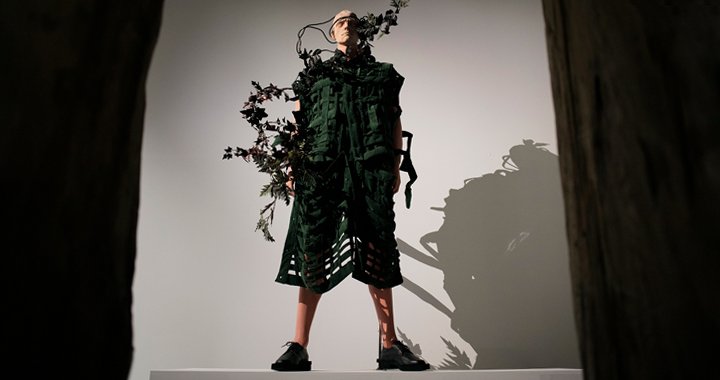
MAREUNROL'S. Stretching borders
The Latvian Museum of Decorative Arts and Design will be presenting the exhibition MAREUNROL'S. Altered States of Fashion from October 10 to December 8
21/10/2019
According to lore, when the Aztecs first spotted the approaching fleet of ships carrying European conquistadors, they only noticed the white sails and not the wooden ships themselves – that’s because in their experienced reality, such massive wooden structures simply didn’t exist. The Aztecs did not have poor eyesight nor were they mentally challenged, yet since they had never encountered such gigantic boats, their minds unconsciously erased what their eyes were seeing. This legend could well be true – according to modern-day scientific research, most people's mental prejudices are so strong that they can easily ignore information that their senses are are picking up if the information is out of line with their previous perceptions of reality. The story of MAREUNROL'S’ presence in the fashion world is the exact opposite – through their creations, they decode the density of information contained in the multifaceted reality of the world by deconstructing, extracting the essence of things, and then visualising it in the universal language of fashion. Basically, they paint with ‘things’. MAREUNROL'S’ fashion creations exhibit both master craftsmanship and intellectualism, constantly encouraging us to look at things/situations/events/life from a different perspective, thereby expanding the boundaries of perception – both theirs and ours.
‘Everything already exists – all of the parts. What is unprecedented is that you take them and using your ideas, put them together somehow differently. You're the constructor. You take all of the flavours and stick them together in a manner that is interesting to you, and at the same time, you hope that this will be tomorrow's fashion language – not something 'of the moment', but a language that people will understand tomorrow and the day after tomorrow,’ Rolands Pēterkops once said in an interview with Arterritory.com.
A total of 17 clothing designs from MAREUNROL'S’ collections spanning from 2005 to 2019 are on view in the exhibition MAREUNROL'S. Altered States of Fashion. By no means a chronological retrospective, it could instead be called a ‘creative inspiration lab’ that decodes the essence of each design; in other words, the show attempts to illustrate the space that each piece occupies in our conscious (and subconscious) minds, as well as the signals that the clothing gives off and any accompanying imaginative narratives that may be provoked. ‘Fashion’ must not be defined by just the low level which the clothes of fast-fashion have vulgarly pulled it down to; it is a language that, brimming with a multitude of diverse signs and symbols, is much stronger than words. More specifically, it is so universal and so explicit that it does not require verbalised explanation.
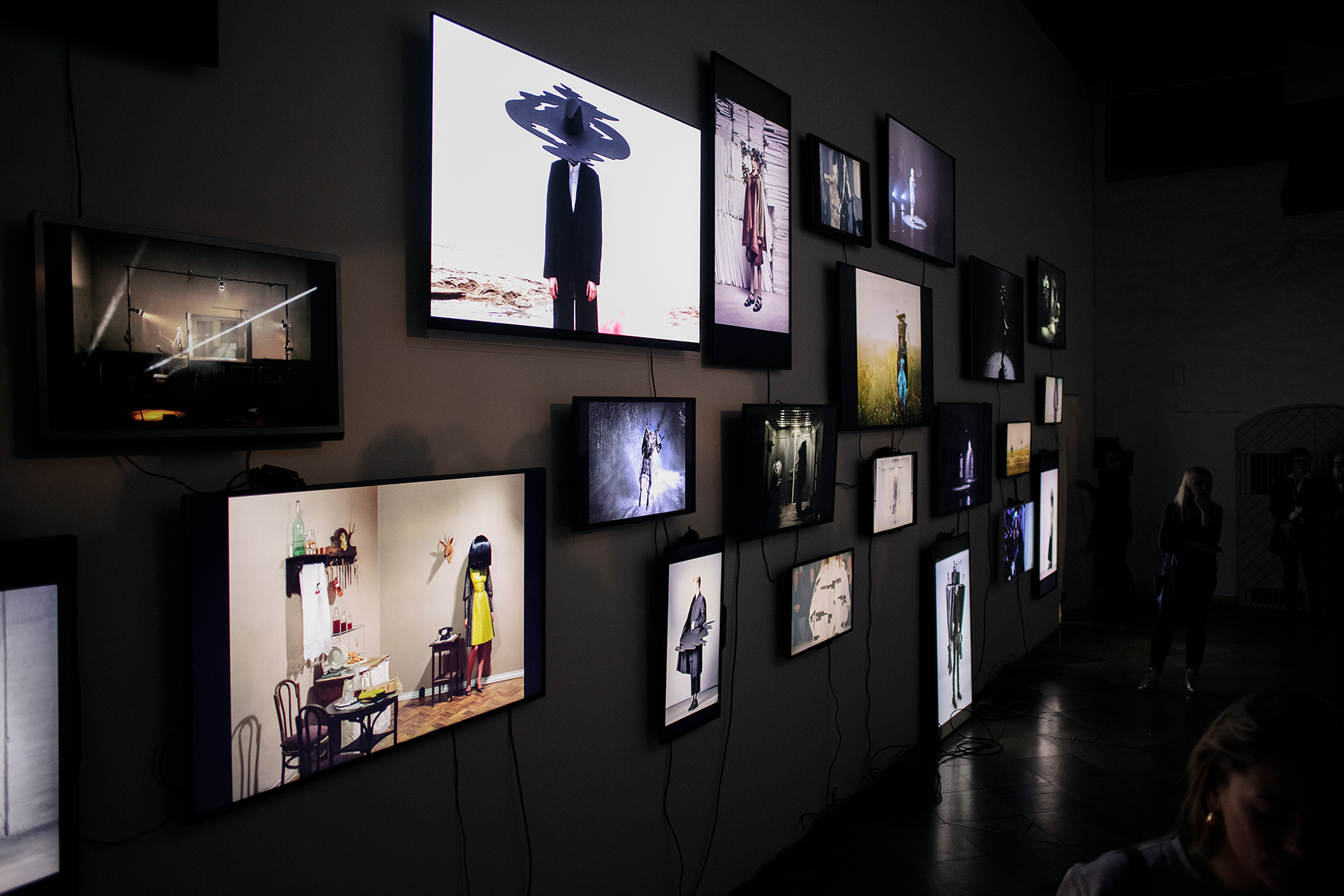
Exhibition MAREUNROL'S. Altered States of Fashion. Photo: Kristīne Madjare
Emphasising the diversity inherent in the language of fashion, as well as its power, MAREUNROL'S place fashion in the middle of an interdisciplinary crossroads where music, art, literature, cinema, life, dreams, and both the material and the immaterial worlds meet. This aspect of their signature style is vividly illustrated in the exhibition by way of the video wall by the entrance to the exhibition hall. In addition to also aiding in softening the hint of stuffiness that tinges the Museum of Decorative Arts and Design, it instantly brings the visitor into the world of MAREUNROL'S’ thoughts and perceptions, where, in a strange and unique way, the spirit of surreal dreamers and the harsh sense of reality come together.
Although one can search for parallels between MAREUNROL'S’ way of design thinking with that of Belgian design (Rolands also studied at the Royal Academy of Fine Arts in Antwerp for several years; already a pronounced walker of his own path, Antwerp just confirmed that they had both chosen the correct path), I believe that there is a thread that significantly connects MAREUNROL’S’ fashion approach with the Japanese fashion revolution of the 1980s. Back then, Japanese designers were creating their own ‘clothing system’, one that was counter to what had been previously accepted by Western society – that is, they offered different ways in which the same item of clothing could be worn. For instance, a top could have two head openings instead of just one; or three sleeves instead of two, leaving the wearer to choose which ones to slip their arms through on a given day. This freed the wearer of having to abide to a didactic correctness and the assumptions imposed by various canons. Of course, this approach to clothing is also a time-consuming process as it requires a certain kind of immersion into the process – which many are unfamiliar with in today's turbulent times. But it does bring something else to the table, namely, time with yourself. One is encouraged to enjoy this time with the self while doing something so seemingly functional as dressing. After all, dressing yourself (i.e. your style) can be an art form if it is approached from the point of view of virtuosity in use of language and sharpness in thought.
.jpg)
Exhibition MAREUNROL'S. Altered States of Fashion. Photo: Una Meistere
If you happen to have a piece by MAREUNROL'S in your closet, then you well know that in addition to the immersive aspect already mentioned, their clothing also hides within it an authentic moment of childlike unpredictability. That’s because whichever way you choose to wear a particular jacket/vest/shirt, that will be the correct way. Clothing created by MAREUNROL'S frees the wearer of any trace of dogmatism, leaving them room for personal freedom and spontaneity. As Rei Kawakubo, the Japanese fashion designer and founder of Comme des Garçons has said: ‘It is useless to create something predictable’.
‘The never-ending story will always be to see what has not been seen, and to look for that which is actually a coincidence or misunderstanding. Basically, to analyse what it is that you are seeing. Often times it is not even all that pertinent to the human body. When working on a collection, essentially, you’re also working more with the space that is between you and the person sitting next to you, or between you and other things. Why is that? We’ve always wanted to show this surreal wit. It could be because it’s something that we don't see anyone else (who is on the same fashion platform at us) doing,’ says Rolands.
In the fashion world, MAREUNROL'S are fine mechanical engineers who turn these coincidences into clothes. But before they start, they cultivate the core concept with an avalanche of associations and vision. An indispensable element commencing each new collection is a mood board onto which they assemble bits and pieces of various thoughts, ideas and whimsies – anything from a pleat spotted on the mantle of a nobleman in a Renaissance-era painting, a scene from a classic film noir, the way Michael Jackson combined ugly sweatpants with a just-as-strange leather jacket in an early-80s concert, to Arvo Pert and the world he has created... It could also just as well be a surreal stopping of time that reveals the beauty that can be found in what we regard as seemingly daily routine. After that has been done, they unceremoniously get rid of everything that is unnecessary, sloughing off the layers in order to get closer to the core idea which will then result in a collection. And which will then go on to filter into photographs, theatre and film costumes, fashion short films, exhibition design layouts...that is to say, into the creative cosmos in which MAREUNROL'S manifest themselves.
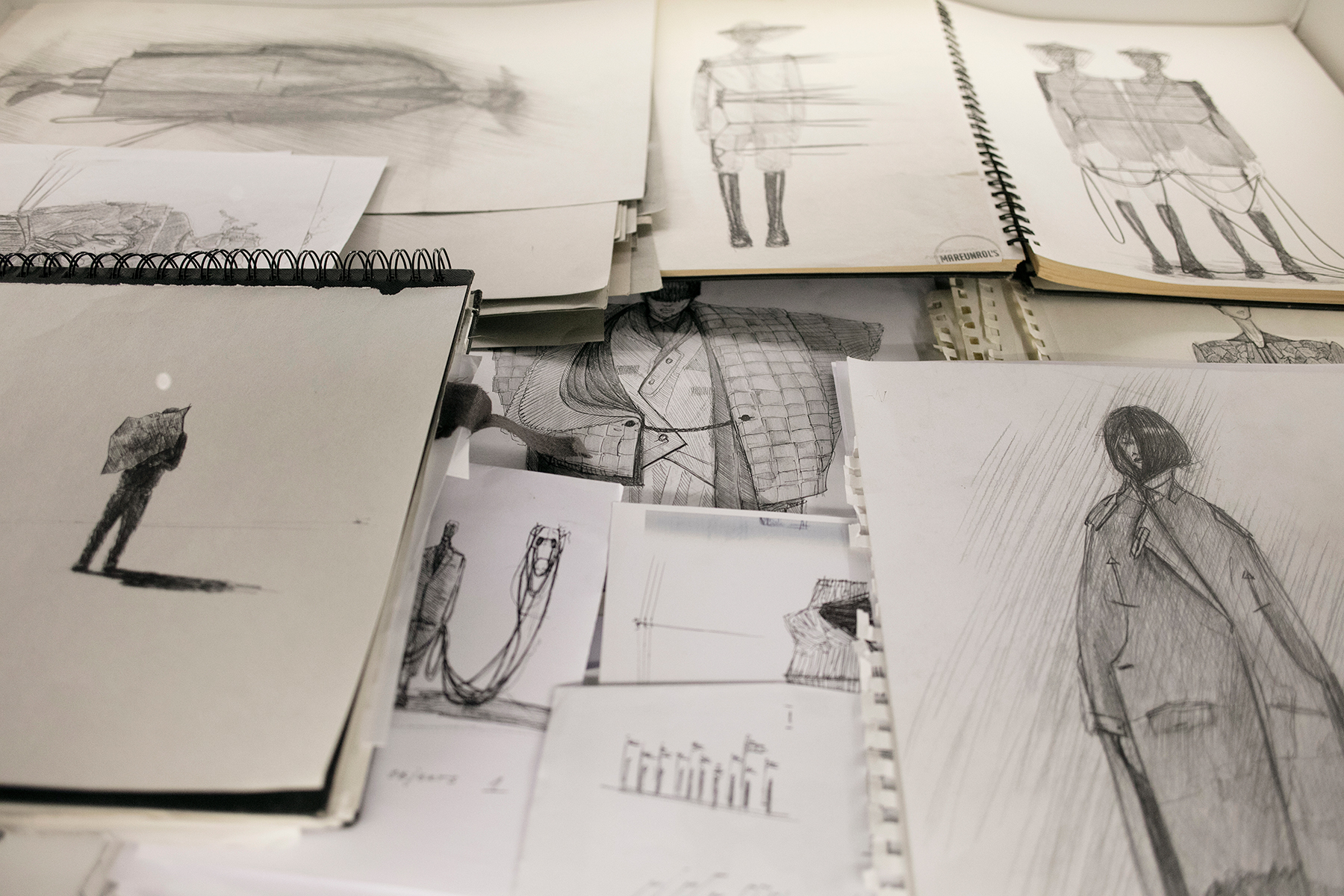
Exhibition MAREUNROL'S. Altered States of Fashion. Photo: Kristīne Madjare
Yet no matter what the source of inspiration for their collection may be – whether an episode from their private lives, a current social issue, or just an observation of life – MAREUNROL'S never fail to include a healthy dose of irony (case in point – note the faces of the manikins in this exhibition!), which gives their clothes a spark of wit and layers of meaning. This characteristic (read: skill) of theirs has been in strong evidence ever since their very first collection as a duo in 2005 – Untitled/only for adults. The idea behind it was to make the seemingly impossible possible: combine two distinct personal stories that have been ‘written’ in different fashion languages – two different aesthetics that, by complementing each other, form a whole.
Untitled/only for adults is a story about the city (which is where Rolands grew up) and the countryside (where Mārīte comes from). It is about the urban jungle and living in a place that is surrounded by nature. If the former is characterised by bare geometry, architectural shapes, deconstruction and contrasts (including the tumult of city life itself), the latter embodies lightness, nuanced tonality, and delicate sensitivity. This interaction of opposites would become the foundation upon which MAREUNROL'S would build its vision and sense of fashion.
With the creation of their brand, it was specifically bluejeans that MAREUNROL’S turned into a multifunctional combination of platform, medium, and tool for their creative experiments. It should be noted, however, that in the classic sense of the word, the creations of MAREUNROL’S could be linked to jeans only in terms of the fabric used. Both designers were well aware that trying to compete in such a well-defined and indeed global business sector would be pointless; instead, MAREUNROL'S undertook the challenge of creating ‘anti-jeans’ – that is, a deliberate ‘wrong’ – in terms of both the clothing’s cut and message. It was the era in which Riga (along with Budapest, Prague, Bratislava and Tallinn) had attracted foreign media attention as being a favourite destination for British bachelor parties. Scandalous side-effects of this influx of alcohol-soaked pleasure seekers were sex tourism and the relieving of oneself at the foot of Latvia’s sacred symbol of independence – the Freedom Monument. Brochures and handbills advertising striptease clubs and ‘massage parlors’ littered the vestibules of the city’s hotels and the floors of taxi cabs. In the local media, Vaira Vīķe-Freiberga, Latvia’s president at the time, strongly voiced her displeasure at this plague of undesirable tourists, stating in an interview that prostitution needs to be brought under control and that other forms of entertainment need to be offered to foreigners. Having found anonymous, copyright-free pornographic pictures on the as yet labyrinthine Internet (which had just started its trajectory of becoming the information highway), MAREUNROL'S, in sarcastic reference to the zeitgeist of the moment, created an ‘adults-only’ jeans collection with labels featuring these bawdy images. Hidden within the seams of their denim trousers, the labels were a Freudian reflection on the mess that existed in the chambers of the collective subconscious.
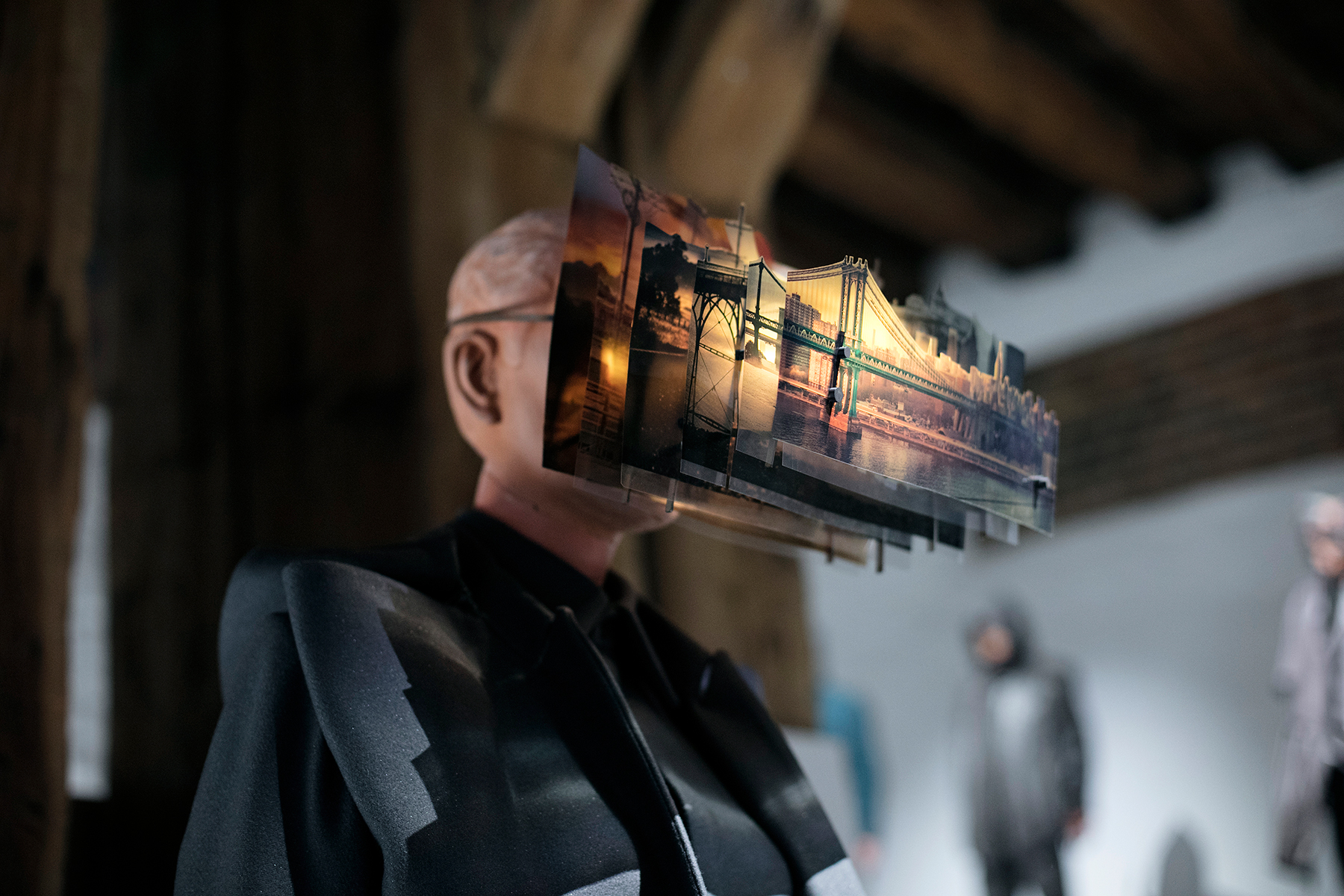

Exhibition MAREUNROL'S. Altered States of Fashion. Photo: Kristīne Madjare
In a similar vein, their latest collection, UNEXPECTED SOURCES 6. Spring/Summer 2020, is a reflection on the vital issue of the moment – climate change, and it symbolically begins with a farewell...no, no, not a farewell to fashion but to the plastic shopping bag. Or, to be more precise, to the aggregate state of consumer culture with which we have consolidated to such a degree that we regard it as an inherent part of ourselves. It is not an easy thing to give up, and the conditional process of ‘purifying’ ourselves from it is full to the brim with double standards. Sustainable design, green thinking, eco-style...how much of it is just words, and to what extent are the fashion industry, designers, and consumers really ready to make changes? An increasing number of fashion houses are announcing that their collections are made from organic and environmentally friendly materials. But isn’t there a good deal of hypocrisy in these statements? Could they just be dressed up as being ‘green’? After all, it’s not just the fabric that is polluting the world – the design and the volume of produced goods is arguably even more harmful. Calling something an eco-material is just an environmentally friendly plaster that does not provide a cure but simply does a masterful job of covering up things we’d rather not see.
Even though the UNEXPECTED SOURCES 6 collection was created at a time when climate change is at the forefront of the world’s problems, MAREUNROL'S emphasises that it is not a 100% organic collection. Nevertheless, it is a collection with which MAREUNROL'S have tried to minimise the expression of their ‘designer ego’. The clothing has been made with an absolute minimum of seams, makes maximum use of the fabric (without leaving remnants), has no unnecessary details, and has not undergone any processing that would require additional resources.
While working on this collection, the duo also designed the costumes for an opera by the young Latvian composer Anna Ķirse. Titled The Tree Opera, it premiered in the forests of the Kainuu region of Finland, and both literally and figuratively led the fashion designers directly into nature, urging them to examine their relationship with it.
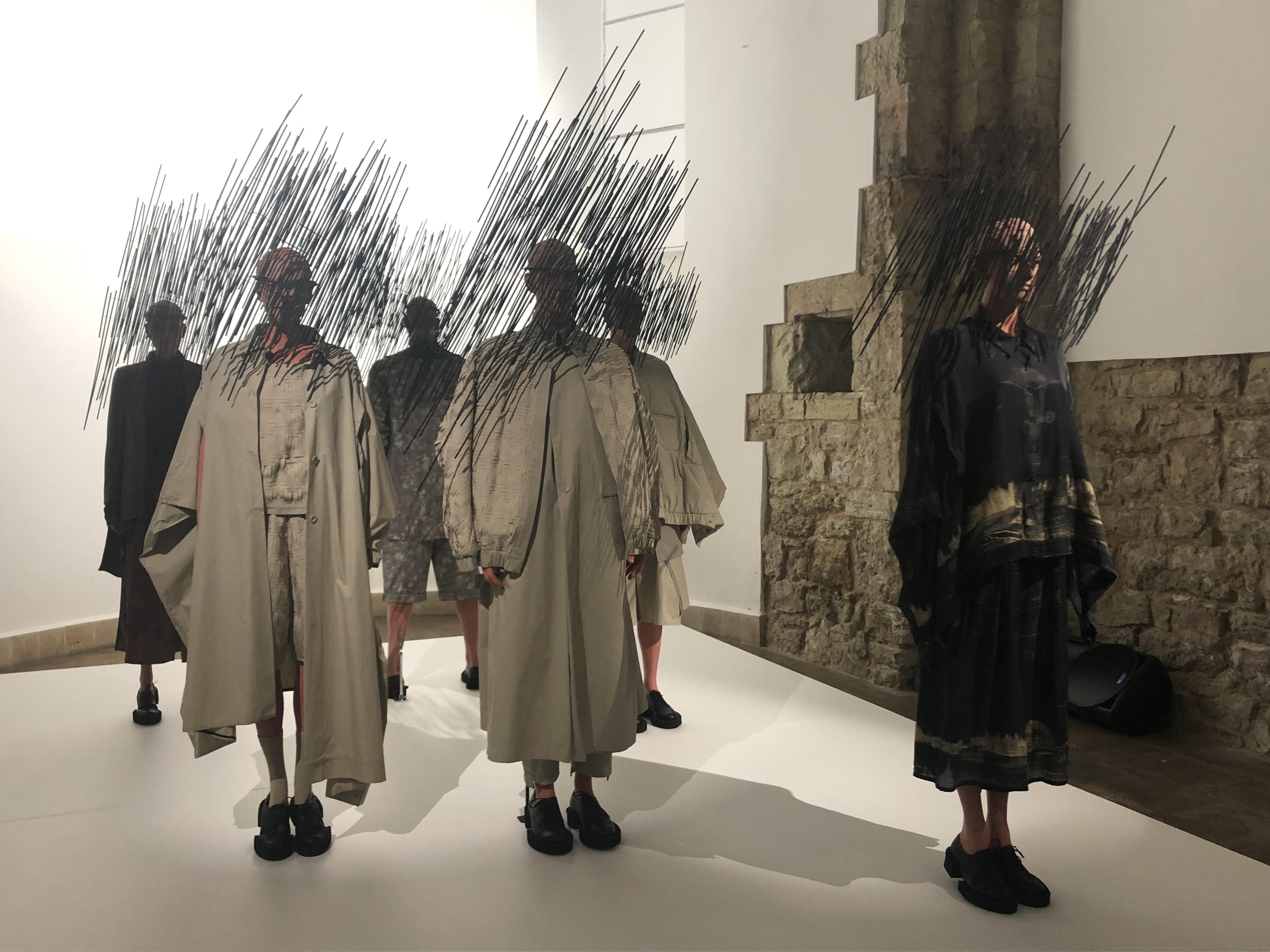
Exhibition MAREUNROL'S. Altered States of Fashion. Photo: Una Meistere
One of the central elements of the collection is a stylised beekeeper hat. In May of this year, the United Nations issued the disturbing announcement that millions of animal, bird and insect species are being threatened with extinction, and at an insane rate at that. Among these are bees. As a result of pollution, their populations in Europe have already shrunk by 37%, with 9% of bee species in danger of completely disappearing. Bees pollinate trees, which in turn create the oxygen that humans breathe; they also pollinate plants that provide food for other insects, birds and animals in the food chain. Bees also increase the yield of commercial crops by 90 percent. As the British newspaper The Guardian writes: ‘The annual contribution of pollination services to the global economy has been estimated at $577bn’. In 2017, the UN adopted Slovenia’s proffered resolution to make May 20 World Bee Day, prompting people to come to the realisation that by saving bees, we are actually saving ourselves.
Another notable feature of the collection is a poncho-style cape designed to urge its wearer to go into the woods and reconverge with the nature that they have intervened with.
A conundrum that MAREUNROL'S (and many others) are still trying to understand is how has the teenager Greta Thunberg managed to succeed in accomplishing within a few months that which a slew of the world’s brightest minds – musicians, artists, directors, etc. – have failed to accomplish despite decades of trying. Thunberg has attracted global attention to the issue of climate change, thereby provoking a barrage of debate and galvanising the belief that it is not too late and if we act now, a turnaround is still possible. After all, Sting has been talking about climate change at his concerts for years now, as has Olafur Eliasson in his artistic projects. Could the uncomfortable answer be that at the core of any action undertaken by an artist, their ‘ego’ plays a part, whereas Greta contains the pure and open heart of an adolescent? How long will it really take until a plastic shopping bag becomes nothing more than an artifact on display in the museum of humanity? And will it just end up being another stylish photograph?

Exhibition MAREUNROL'S. Altered States of Fashion. Photo: Kristīne Madjare
‘We don't like being understood in such a primitive way. Because the way in which you work is your identity,’ says Rolands. This exhibition is just a captured frame enclosing a period of time, while MAREUNROL'S continue on, examining both life and fashion.